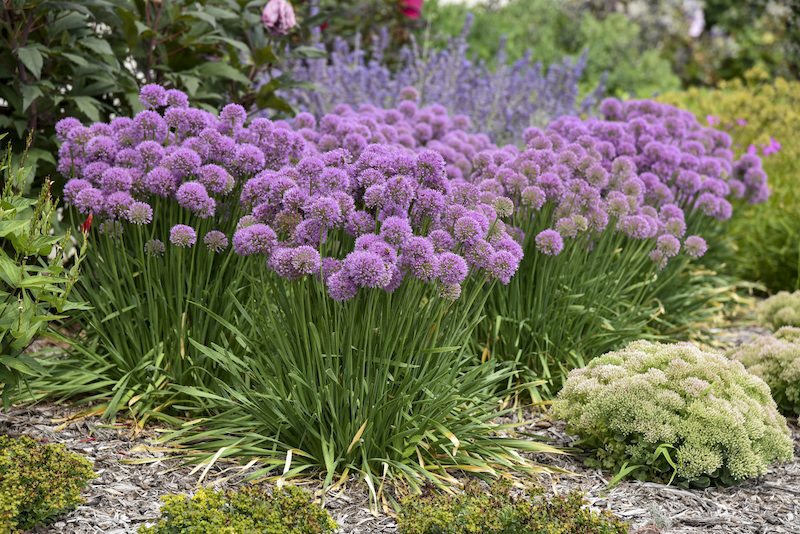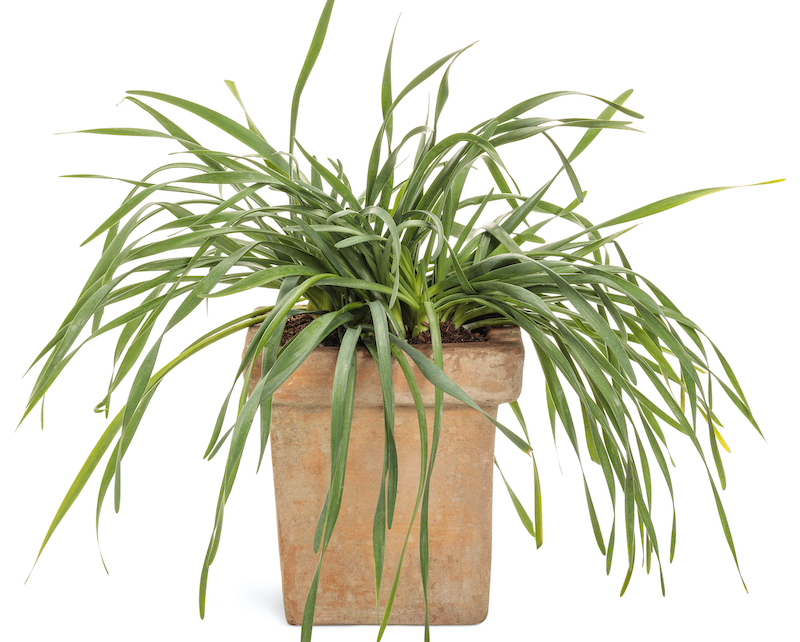Alliums are a family of plants that contains both ornamental and edible plants. This plant family includes common vegetables such as onions, garlic and leeks as well as herbs like chives. The ornamental members of the allium family are grown as bulbs and range in size from 6 inches tall to over 4 feet. All of these perennial bulbs have flowers that are showy and some even as big as 8 inches across.
The flowers are lovely in bouquets and will have the faint smell of onions. Some of the larger flowering varieties make stunning dried flowers with a dramatic and modern flair. All alliums, regardless of ornamental value, prefer full sun with well-draining soil. The smaller varieties of alliums can be used as container plants or an edible edging around garden areas. Chives in particular are great edible plants that can be used ornamentally.
All alliums are quite hardy in colder temperatures, and the ornamental varieties need next to no maintenance.

Planting Alliums
Alliums generally are planted as a bulb. Chives are sold in pots and can easily spend their whole lives in a container. In the milder growing range, onions and garlic can be planted in the fall and harvested by early summer of the next year. In colder hardiness zones where there is typically snow all winter, onions and garlic should be planted in early spring. Some onions are planted in groups of bulbs called onion sets.
The bulbs of the ornamental varieties are best planted in the fall when other spring bulbs are planted. This will give the alliums time to establish roots before the top growth emerges in the spring. Choose a location that has full sun exposure and well-draining soil. Always plant the ornamental bulbs twice as deep as they are tall. This results in a very stable plant that will be strong enough to support a large flower head. Edible onions and garlic will need to be planted a bit more shallow. The top of the bulb needs to be just ½ to 1 inch below the soil.
Watering Alliums
The watering requirements for ornamental and edible alliums is pretty much the same. They will thrive in drier soils, but regular watering will produce larger bulbs and flower heads. Long, infrequent watering sessions will result in a sturdy, deep root system that tolerates drought and heat better. When ornamental Alliums are established they may not need any supplemental watering. Edible Alliums, such as chives, will need regular watering of about ` inch of water per week. The soil needs to be kept evenly moist and can benefit from mulching with organic material such as chopped up leaves, finely shredded bark, arborist chips or organic compost.
Fertilizing Alliums
Using a granular fertilizer is best for all bulbs. A well-balanced, slow-release blend will give Alliums the right nutrition to develop strong stems, bright flowers, and larger bulbs. Mulching perennial Alliums in the early spring with organic compost will often be sufficient for supplemental feeding. Hungrier edible Alliums like garlic and onions will need a good feeding of a granular, slow-release food when they are planted and then can be fed again with a diluted liquid emulsion like seaweed or fish after the new growth reaches 6 inches tall.
Applying too much fertilizer, too often will not usually result in larger bulbs and may make the plant weak and prone to infection from diseases. Fertilizers that are higher in nitrogen will produce lush stems while sacrificing the bulb.
Pruning Alliums
The perennial varieties of Allium are the only ones that need annual maintenance and pruning. The best time to give perennial Chives a trim is in the spring after they have finished blooming. This will help to keep the plant from self seeding. Other ornamental Alliums should be deadheaded after blooming while leaving as many leaves as possible to die back naturally. The bulbs require the leaves to make food and feed the bulb to prepare for next year's growth. Most of the ornamental Alliums have long, strappy leaves that are attractive for the rest of the summer.
Edible types are cut back as they are harvested. Chives can be cut numerous times during the summer to supply fresh leaves for cooking.

Caring For Alliums in Pots
Most Alliums can be grown in containers and make nice additions to a patio, deck or smaller garden. Make sure to use deep pots when growing edible Alliums such as onions and garlic. The only allium that does not grow well in containers is leeks. They require deep soil that can be hilled up to blanch their stems, although baby varieties may be worth a try since they do not need to be blanched. Make sure that any pot used has excellent drainage. Any standing water will rot Allium roots and make the plants prone to fungus and mildews.
Ornamental Alliums can be planted the same way spring bulbs are planted in containers. Single varieties planted in large amounts have the most impact and drama.

Winter Care for Alliums
Ornamental Alliums need little winter maintenance. Upon the first frosts of fall, the foliage dies to the ground andthebulb will prepare to go dormant for the winter. A little extra mulch will help to insulate cold soil and indicate where the Allium is to avoid disturbing it. Edible perennial Alliums respond to a good cutback to within 6 inches from the ground. This will keep the crown of the plant from rotting over the winter.
Edible annual Alliums may need to be planted and mulched for the winter or harvested completely and stored until replanting next spring. Garlic and overwintered onion sets should be planted well before any hard freezes and snow. Mulching with a layer of partially decomposed straw will provide enough insulation for the roots to begin growing.
Common Questions About Allium
Why Are Allium Leaves Dying?
Nitrogen Deficiency can cause the older leaves of allium plants to turn yellow. Other symptoms would be stunted growth.
Why Are Allium Wilting?
Alliums require a lot of sunlight and are drought-tolerant. They will stretch and weaken when not they don't get enough sunlight causing them to droop.
How Long Do Allium Bulbs Last?
If stored correctly, can be kept for about 12 months before needing to be planted.
Do Allium Bulbs Flower Every Year?
Yes, if planted in a suitable environment- they will bloom in their first year, and will return year after year.
Do Allium Like Acid Soil?
Slightly acidic soil pH, at around 5.5 to 6.5 is preferred by Alliums.
Will Allium Grow In Shade?
A shade that is early in the day or late in the afternoon will be acceptable as long as the full sun exposure is 6 or more hours.
Do Bees Like Allium?
Alliums are bee and butterfly magnets.
Is Allium Invasive?
Some varieties may run the risk of becoming invasive.
Is Allium An Annual or Perennial?
Ornamental alliums are perennial bulbs that die back completely to the ground and remain dormant during the winter months.
Why Are Allium Leaves Turning Yellow, Brown, and/or Black?
Leaves typically turn yellow to brown when the plants indicate it is almost time for harvest. It is perfectly normal. However, Leaves that turn yellow may be a symptom of Nitrogen deficiency.
What Is The Growth Rate of Allium?
These bulbs will grow quickly and they will multiply over 2 to 4 years. Once planted, germination starts at 12 weeks.
Is Allium Drought Tolerant?
Alliums are drought resistant and don't typically require the extra irrigation that other perennials need. Make sure to plant them near other plants that prefer less water. Alliums planted near thirsty plants that rely on extra irrigation will receive too much water and start to rot.
Have a question about Alliums? Fill out the form below and we will try and get back to your question as soon as possible. We may even feature your question in this article to help other gardeners!
 |
Author Robbin Small - Published 7-14-2022 |
